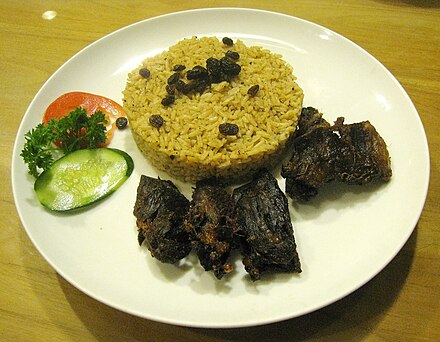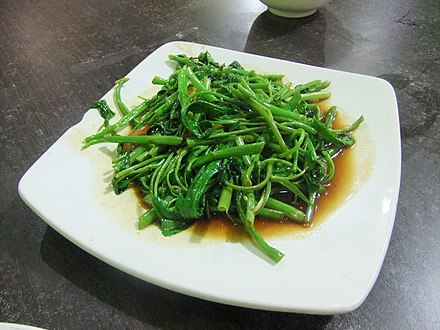Indonesian cuisine
Indonesian cuisine
Indonesian cuisine is an umbrella term referring to the culinary traditions spanning the archipelago of Indonesia, using different ingredients and spices to create a rich and flavourful masterpiece. It influences the cuisine of neighbouring Malaysia and Singapore. Also, it can be found in a country that has a long history with Indonesia such as Netherlands and Suriname.
Understand
With 17,000 islands to choose from, Indonesian food is an umbrella term covering a vast variety of regional cuisines found across the nation. But, if used without further qualifiers, the term tends to mean the food originally from the central and eastern parts of the main island Java. Now widely available throughout the archipelago, Javanese cuisine features an array of simply seasoned dishes, the predominant flavourings the Javanese favour being peanuts, chillies, sugar (especially Javanese coconut sugar), and various aromatic spices. All too often, many backpackers seem to fall into a rut of eating nothing but nasi goreng (fried rice), but there are much more interesting options lurking about if you're adventurous enough to seek them out. In addition to Javanese cuisine, Minang and Sundanese dishes have spread throughout the country.
National main dishes
The predominant cuisine in Indonesia is Javanese. As the name indicates, it originates from the main island of Java, but the cuisine has absorbed many influences: originally Chinese ingredients like noodles and tofu are now an integral part of Indonesian cooking, and the Dutch left an abiding love for breads and cakes. Javanese migrants have brought their dishes across the entire archipelago, so these dishes are available essentially everywhere. Not only Javanese, but also, as well as Minang cuisine that has spread throughout Indonesia. The most famous is Nasi Padang. Another food Rendang has become the national dish of Indonesia. Other, Sundanese cuisines, siomay and batagor, Madurese sate Madura and Palembangese pempek can be easily found all over the main island of Indonesia.
Rice
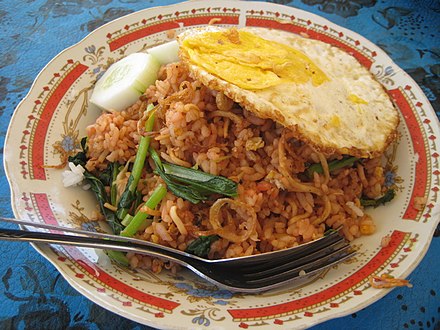
The Indonesian staple is nasi putih (white rice), while ketan (sticky rice) is frequently used for particular dishes and many snacks. Red rice is available and rapidly becoming more popular. Rice is so important that it has several different names depending on what stage in the growing/consumption process it is in, from padi when growing in the rice paddy (hence the English word), gabah when harvested but not yet husked, beras in the cleaned state before being cooked, and nasi once steamed on your plate. Rice is served up in many forms including:
- Bubur ayam. , rice porridge with toppings and chicken broth, popular at breakfast, generally salty.
- Ketupat. and Lontong. , rice wrapped in leaves and cooked so it compresses into a cake. Often served with vegetables (sayur) cooked in coconut milk soup.
- Nasi goreng. , the ubiquitous fried rice; order it special to get an egg on top. Eaten at any time, even breakfast.
- Nasi kuning. , yellow spiced rice; popular at breakfast, the festive ceremonial dish version is moulded into a sharp cone called a tumpeng.
- Nasi liwet. , white rice served with roughly shredded chicken, opor (coconut milk soup), eggs and other add-ons, including internal organs and quail eggs, traditionally served late at night.
- Nasi Padang. , white steamed rice served with numerous curries and other toppings, originally from Padang but assimilated throughout the country with lots of variations and adjustments to taste.
- Nasi uduk. , slightly sweet rice cooked with coconut milk, eaten with topping (omelette, fried chicken, etc.); popular at breakfast.
Bubur ayam, lontong/ketupat sayur, and also nasi kuning are usually available in the morning only.
Noodles
 Noodles (mi or mie) come in a close second in the popularity contest. Most stalls nowadays offer bakmi or mie ayam. , fresh noodles with shredded chicken and one kind of vegetable and cost Rp10,000. Every region has its own specialty of noodle dishes, which you may see in the regional cuisines section, the dish is with the prefix mie.
Noodles (mi or mie) come in a close second in the popularity contest. Most stalls nowadays offer bakmi or mie ayam. , fresh noodles with shredded chicken and one kind of vegetable and cost Rp10,000. Every region has its own specialty of noodle dishes, which you may see in the regional cuisines section, the dish is with the prefix mie.
- Bihun, long, thin, white (poorer quality are blue), round rice flour noodles are usually fried or added to certain dishes.
- Kuetiaw/kwetiau/kway-tiau, flat rice noodles most commonly fried up with soy sauce be named kwetiau goreng. , but can also be served in broth-based soups (less commonly).
- Pangsit, the Indonesia version of wonton, this Chinese "ravioli" pasta are stuffed with a bit of meat and are very soft, most often served fried in or with soup, or served "wet" in broth.
- So'un, long, thin, usually transparent (best quality), round vermicelli ("glass" or "bean thread" noodles) made of starch from beans, cassava and other sources are usually used in soups.
Soups
 Soups (sop) and watery curries are also common. Soup can be the main course, not just a starter:
Soups (sop) and watery curries are also common. Soup can be the main course, not just a starter:
- Bakso. (BA'-so) — beef, chicken, fish, or prawn balls in broth with glass noodles. Bakso from Malang and Solo is very well-known in Indonesia.
- Lodeh. (LOH-day) — thin coconut milk broth. Usually vegetable-based, but lodeh tempe is also found.
- Pindang. — Indonesian fish soup, the technique is native to Sumatra especially in Palembang, but has spread to Java and Kalimantan. In Maluku and Papua, there is a fish soup with turmeric called ikan kuah kuning. The coconut milk-based fish soup, mangut is common in Central Java.
- Rawon. (RAH-won) — spicy beef soup, coloured black by the keluak nut Pangium edule, a speciality of East Java.
- Sayur asam. — from the Sundanese cuisine of West Java. Clear vegetable soup soured with asem Jawa (tamarind) and belimbing wuluh (a variety of starfruit Averrhoa bilimbi).
- Sayur bening — spinach, carrot, corn, and cubed chayote in clear broth.
- Soto. — Indonesian meat soup, commonly beef or chicken. Widely available, with many local variations.
Main dishes
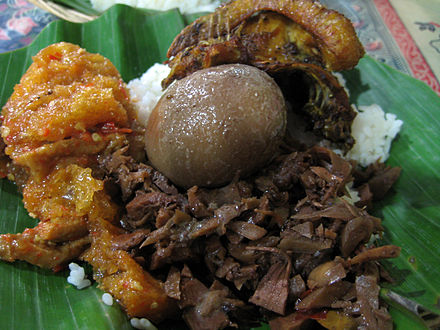
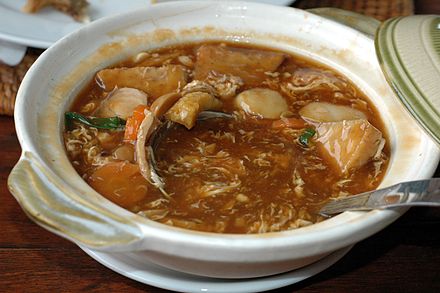
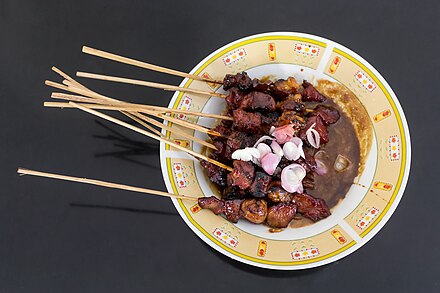 Popular main dishes include:
Popular main dishes include:
- Ayam bakar. , grilled chicken.
- Ayam goreng. , deep-fried chicken. There is also the spicy smashed fried chicken called ayam geprek. .
- Cap cay. , Chinese-style stir-fried vegetables, usually with chicken, beef or seafood.
- Gado-gado. , blanched vegetables with peanut sauce. The two version, gado-gado Betawi Jakarta and gado-gado Surabaya is very common dish. The difference is the vegetables they use and the ingredient of the peanut sauce.
- Gudeg. , jackfruit stew from Yogyakarta. It always equipped with various kinds of side dishes, two of which are sambal goreng krecek. , cow or buffalo skin in spicy chili paste sauce and bacem. , traditional Javanese cooking method, egg, tempe, or tahu boiled in coconut water mix with spices and brown sugar.
- Ikan bakar. , grilled fish.
- Ketoprak. , a vegetarian dish from Jakarta, mainly consists of ketupat, tahu (tofu), toge (beansprouts), peanut sauce; it is sometimes served with boiled or fried egg. The similar dish with petis (black coloured shrimp paste sauce), tahu tek or tahu telor, also popular in East Java and Eastern Indonesia.
- Pecel. , a Javanese salad with peanut sauce. It is usually eaten with carbs (steamed rice, lontong or ketupat) also gorengan (fritter) such as bakwan sayur, tahu isi/tahu susur or tempe mendoan. There is a noodle version called mie pecel, made from noodles, carrots, cabbage, and slices of bakwan (veggies fritter) in a bumbu pecel (peanut sauce).
- Pempek. or empek-empek comes from Palembang, Sumatra and is made from ikan tenggiri (mackerel) and tapioca, with different shapes (lenjer, keriting), some of which may contain an egg (kapal selam), some form of onion (adaan) or papaya (pistel), steamed and then deep-fried and served with chopped cucumbers in a sweet and spicy vinegar- and sugar-based sauce (cuko). Some recipes taste fishy while others are fresh. Beware pempek that is very cheaply priced - it probably has a disproportionate amount of tapioca and will be rubbery. Good pempek should be mildly crunchy outside and soft (but very slightly rubbery) inside, and the sauce's flavour should be able to soak into it after a while.
- Perkedel. , deep-fried patties of potato and meat or vegetables (adopted from the Dutch frikadel).
- Rendang. , a spicy, dry coconut curry from Padang; the most famous type is beef rendang.
- Sapo tahu. , Chinese-Indonesian style claypot stew of tofu, usually with vegetables and meat or seafood. There is also the noodle version called sapo mie.
- Siomay. , an Indonesian steamed fish dumpling with vegetables served in peanut sauce. It can be combined with batagor. .
- Sate. (satay), grilled chicken, beef, goat or, rarely, pork, lamb, horse, or rabbit on a skewer and served with sauce (several varieties, but peanut sauce is most common). The vegetarian version of satay is also common in Indonesia like sate jamur (oyster mushroom satay) and sate kere from gembus (Javanese tofu dregs).
Condiments
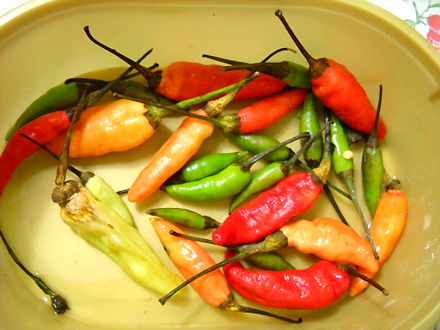

Chillies (cabe or lombok) are made into a vast variety of sauces and dips known as sambal and saus sambal. The word sambal is a loan word from the Javanese and Sundanese sambel. The simplest and perhaps most common is sambal ulek (also spelled oelek), which is just chillies and salt with perhaps a dash of lime ground together using a mortar and pestle. There are many other kinds of sambal like sambal pecel (with ground peanuts), sambal terasi (with dried shrimp paste), sambal tumpeng, sambal mangga (with mango strips), sambal hijau (using green chilli), sambal bajak (fried, usually with tomatoes), etc. Many of these can be very spicy indeed, so be careful if you're asked whether you would like your dish pedas (spicy). There may be a bottle of something that looks like ketchup on your table: this is Sambal ABC (ah-beh-cheh), one of the brands of saus sambal, a fiery garlic and chilli sauce, or one of its many imitators (the real thing is branded Asli, "Original"). Many Indonesians also eat raw chili cabe rawit when they eat salty fritters.
Crackers known as kerupuk (also spelled krupuk and keropok) accompany almost every meal and are a traditional snack, too. They can be made from almost any grain, fruit, vegetable or seed imaginable, including many never seen outside Indonesia, but perhaps the most common is the thin, light pink, rectangular kerupuk udang, made with dried shrimp, and the slightly bitter, small and thin, light yellow emping, made from the nuts of the melinjo (Gnetum gnemon) fruit, as well as those made with cassava or fish, both of which are usually large, round or square and white or orange off-white, although smaller varieties exist with vivid colours like pink. Most kerupuk is fried in oil, but a machine has been devised that can instantly cook a chip with high heat. In a pinch, kerupuk that has been created by pouring the batter in a curly pattern can be soaked in broth to do double duty as noodles - a good way to make use of soggy krupuk. Another Indonesian cracker is rempeyek or it can be shortened peyek, made from flour (usually rice flour) with other ingredients, bound or coated by crispy flour batter. The other ingredients can be anchovy, prawn, rebon (small shrimp), ebi (dried shrimp), citrus leaf slices, chilli, spinach, peanut, and beans such as mung beans, red beans, and soybeans. More niche variants with insect ingredients, like crickets, termites, and mole crabs.
What North Americans call chips and Britons call crisps (not to be confused with kentang goreng, or French fries) are keripik to Indonesians. Potato chips exist, but they play second fiddle to cassava chips, and you can also find chips made from other fruits and tubers, such as sweet potatoes and bananas. Keripik is not as commonly eaten as kerupuk, and it is best to eat both kinds immediately or store them in an airtight container as they readily absorb moisture in the air and become soggy.
Sweet, vinegary pickled vegetables called acar ("ah-CHAR") are often served with certain dishes, especially noodles and soups. It almost always contains chopped-up cucumber, but may also have chili peppers, chopped carrots, and shallots in it.
Typical condiments for ladling on yourself include sweet soy sauce (kecap manis), a sweetened aromatic soy sauce, originating in Indonesia, which has a darker color, a viscous syrupy consistency, and a molasses-like flavor due to the generous addition of palm sugar or jaggery. Each region has its specialty brand of kecap manis such as Mirama in Semarang, Segi Tiga in Majalengka, Siong Hin (SH) in Tangerang, Zebra in Bogor etc. More or less, there are a hundred regional brands of kecap manis. The other condiments are salty soy sauce (kecap asin), and cuka (vinegar). If you're looking for Western tomato sauce, you can try asking for saus tomat, available at the convenience store or mini-mart.
Desserts

Dessert in the Western sense is not common in Indonesia, but there are plenty of snacks to tickle your sweet tooth. Kue covers a vast array of cakes and certain pastries made from coconut, rice or wheat flour and sugar. Colourful, sweet, and often dry and a little bland, they're meant to be eaten with tea or coffee. Kue kering usually refers to biscuits and come in a vast variety. Roti (bread) and western-style cakes have gained popularity, mostly in large cities, but traditional and Dutch breads and pastries are available in many bakeries and supermarkets.
Some popular traditional desserts include:
- Bika Ambon. , a somewhat pleasantly rubbery yeast-raised cake from Medan that has an enjoyably aromatic taste.
- Cantik manis, sweetened firm rice flour pudding with colourful balls of tapioca and some people like to eat Javanese (block) sugar by itself. its texture and flavour make it enjoyable for many.
- Kue leker. , a type of Indonesian crepe, made with wheat flour, eggs, milk, and sugar.
- Klepon. , a Javanese favourite, balls of rice flour filled with liquified Javanese sugar and coated with shredded coconut.
- Kolak. , made from banana, pumpkin, or cassava with palm sugar or coconut sugar, coconut milk, and pandan leaves. The without coconut milk version is setup pisang, using banana as the main ingredient with the addition of cinnamon and clove.
- Lapis legit. , an egg-based cake of many thin layers, often flavoured with certain spices.
- Martabak manis aka kue Bandung or terang bulan, yeast-raised flat bread cooked fresh and with chocolate, cheese, nuts, or any combination of the three. Not to be confused with the savory Indian murtabak.
- Naga sari. (lit.: the essence of dragon), banana inside of firm rice flour pudding that has been steamed in banana leaves.
- Pisang goreng. , batter-fried banana. Also, the chocolate version, pisang cokelat. .
- Pisang molen. , the banana version of pigs in a blanket.
- Puding, a pudding made firm with agar-agar and served with vla poured over it, which is a sauce.
- Pukis. , like a half-pancake with various toppings already added.
Some cakes and pastries here may be served with sweetened meat floss (abon) or a liberal dose of shredded cheese, and one favourite during Ramadan is the Dutch kaastengels, a rectangular cheese-flavoured cookie that is only slightly sweet.
Due to the hot climate, various desserts based on ice (es) are very popular. Avoid stores that are not clearly using commercially packaged ice.
- Es buah, "fruit ice", is shredded ice mixed with fruits and sometimes sweet potatoes or nuts and topped with coconut cream or condensed milk.
- Es campur. , "mixed ice", is much the same but with ingredients like red beans, grass jelly, coconut, and more.
- Es cao or cincau, an iced of black or green grass jelly.
- Es cendol or dawet, an iced sweet dessert that contains droplets of green rice flour jelly, coconut milk and palm sugar syrup.
- Es puter. is traditional Indonesian ice cream, made from coconut milk and flavored with anything from chocolate to durians.
- Es teler. is an Indonesian fruit cocktail. Avocado, coconut meat, grass jelly, jackfruit, and other fruits are served with coconut milk, sweetened condensed milk, and pandanus leaf. The most famous chain of es teler is Es Teler 77.
- Rujak es krim, One of the rujak. variants with ice cream made from coconut milk. The speciality dessert from Yogyakarta.
Fruit
Perhaps the cheapest, tastiest and healthiest option, though, is to buy some unprepared buah segar (fresh fruit) with rotating variations throughout the year. Popular options include mangga (mango), pepaya (papaya), pisang (banana), apel (apple), kiwi (kiwi fruit), belimbing (starfruit), semangka (watermelon), melon (honeydew melon) and jambu biji (guava), but more exotic options you're unlikely to see outside Southeast Asia include the scaly-skinned crisp salak (snakefruit), jambu air (rose apple), duku (lanzones), gandaria (plum mango), burahol (kepel apple), rambutan (Nephelium lappaceum fruit, whose name aptly means "the hairy one"), the ball-shaped markisa (fresh passionfruit, much larger than the sad, wrinkly specimens seen in the West) and the Queen of Fruits, the incomparably tasty manggis (mangosteen).
Probably the most infamous Indonesian fruit, though, is the durian. Named after the Indonesian word for thorn, it resembles an armor-plated coconut larger than a human head, and it has a powerful odour often likened to rotting garbage or the smell used in natural gas. Inside is yellow creamy flesh, which has a unique sweet, custardy, avocadoey taste and texture. It's prohibited in most hotels and taxis but can be found in traditional markets, supermarkets and restaurants. Don't panic - it's just a fruit, even if it does look like a spiked fragmentation bomb.
The durian has three cousins, all seasonally available.
- cempedak (Artocarpus integer fruit), very similar to jackfruit but the flesh is a darker, near-orange colour.
- nangka (jackfruit), the world's largest fruit, which can easily grow to be over 20 kg. Looks similar to the durian, but has a sweet, candy-like flavour and no offensive smell, and the unripe fruit is used in the famous Yogyakartan gudeg curry. Due to the enormous size, often sold already peeled.
- sukun (breadfruit), rounder and less scaly, usually cut and fried to be eaten for a snack. Tastes like jackfruit but smells weakly like durian, usually no longer than 30 cm.
Regional cuisines
While Javanese food is predominant on the main islands, there are many regional cuisines to explore. They're covered in detail in the regional articles linked below, but here's a quick overview.
Acehnese
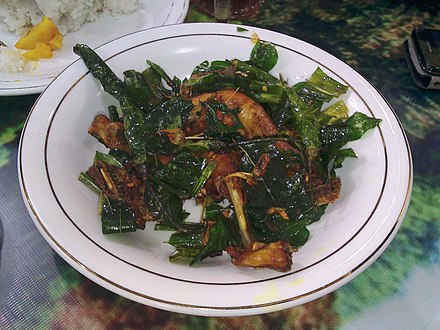 The foods from Aceh province.
The foods from Aceh province.
- Ayam tangkap. , Acehnese cuisine is made from fried chicken with special herbs and spices.
- Mie Aceh. , an Acehnese curried spicy noodle dish. The thick yellow noodle is served with slices of beef, goat meat, lamb, mutton, and seafood, such as shrimp or crab.
- Mie caluk. , a noodle dish which is commonly found in traditional markets and food courts in Pidie Regency and Pidie Jaya Regency. It is a noodle dish served with a splash of thick spicy sauce made from a mixture of tomato, chili pepper or chili sauce, coconut milk, ground peanuts, spiced with shallot, garlic, lemongrass, and citrus leaf, and served with pieces of vegetables, sliced cucumber, and krupuk (crackers).
- Sate gurita, an octopus satay of Sabang.
- Sie reuboh. , made from beef or buffalo stew that is only seasoned with shallots, garlic, cayenne pepper, red chilies, and pepper.
Balinese
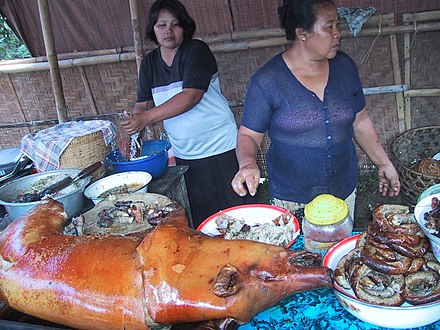
Main article: Bali#Eat
Hindu Bali does not have the Muslim taboo against pigs, so pork is very popular on the island. However, Balinese cuisine avoids the use of beef, as cows are considered to be sacred and thus, inviolable in Hinduism.
- Babi guling, roast suckling pig, hugely popular and very tasty.
- Betutu. , a Balinese dish of steamed or roasted chicken or duck in rich spices.
- Lawar, "salads" of chopped coconut, garlic, and chili pepper, often with pork or chicken meat or blood mixed in.
- Rujak kuah pindang. , slices of fruits smothered in a broth made from fish, salt, shrimp paste, and chili.
- Sate lilit. , the Balinese spin on satay, using minced meat pressed onto lemongrass skewers.
- Tipat cantok. , boiled vegetables and ketupat (rice cake), served with peanut sauce.
- Tum ayam, spiced steamed chicken in banana leaf.
Banjarese
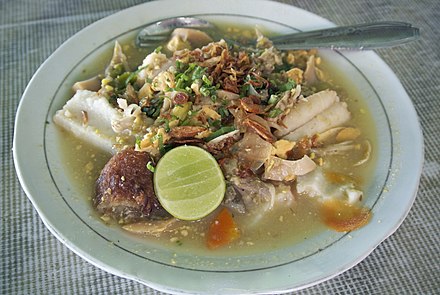 You may see Banjarese cuisine in South Kalimantan.
You may see Banjarese cuisine in South Kalimantan.
- Mandai, a Banjarese side dish of fried cempedak fruit skin.
- Mie bancir. , This noodle is named so because the presentation is not dry and not too wet and is topped with chicken meat, pond duck eggs, and limau kuit, a citrus which are typical of South Kalimantan.
- Nasi kuning haruan, a yellow-coloured rice with snakehead fish in masak habang (Banjarese red sauce).
- Soto Banjar. , a typical Banjarese chicken soto.
Batak
 North Sumatra is a home of Batak cuisine. As most Batak are Christians, many traditional Batak dishes make use of non-halal ingredients such as pork and dog meat.
North Sumatra is a home of Batak cuisine. As most Batak are Christians, many traditional Batak dishes make use of non-halal ingredients such as pork and dog meat.
- Arsik. , a Batak style spicy fish dish.
- Babi panggang. , roasted pork belly
- Dali ni horbo. , a dish made from water buffalo milk.
- Mie gomak. , a Batak thick spicy noodle soup dish served in coconut milk and andaliman-based broth, the specialty of Toba Batak region of North Sumatra.
- Na niura. , the complete raw fish is served with condiments, so that would make the fish feel better without cooking, which means that the spices that are cooked goldfish.
- Ombus-ombus. , a North Tapanuli dish of cakes made of rice flour was given sugar in the center and wrapped in banana leaves.
- Saksang. , pork or dog meat stewed in its own blood.
- Sambal tuktuk. , a traditional hot and spicy condiment typically served in Batak cuisine.
Betawi
Jakarta was once known as Batavia, so Betawi cuisine originates from Greater Jakarta.
Rice
- Nasi kebuli. , an Arab-Betawi dish. This rice is cooked with mutton broth, goat's milk and ghee, served with fried mutton and sometimes sprinkled with sliced dates or raisins.
- Nasi ulam. , steamed rice served with various herbs and vegetables. The herbs are being used especially the leaves of pegagan (Centella asiatica). Served with various side dishes such as dendeng beef jerky and omelette.
Noodles
- Mie juhi, native noodle dish of Betawi, noodles with vegetables and dried squid in peanut sauce.
- Mie kangkung. , a Chinese-Betawi dish. Noodles with water spinach in savoury thick gravy sauce.
Soups
- Gabus pucung, snakehead fish (gabus) flavored with fermented black keluwek nuts.
- Soto Betawi. , beef offal soup with diced tomatoes and slices of fried potato.
Buginese and Makassarese
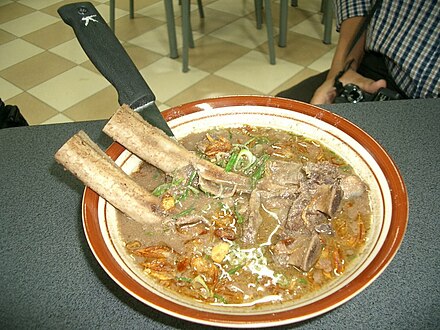
- Barongko. , a mashed banana mixed with eggs, coconut milk, sugar, and salt then wrapped in banana leaf and steamed.
- Coto, a spiced beef soup.
- Es pisang ijo. , a cold banana wrapped in green dough dessert.
- Jalangkote. , fried dumpling stuffed with rice vermicelli, vegetables, potatoes, and eggs. The spicy, sweet, and sour sauce will be dipped into prior to be eaten.
- Konro. , a rib of beef dish.
- Mie kering Makassar. , a Chinese-Makassarese cuisine, a type of dried noodle served with thick gravy and sliced chicken, shrimp, mushrooms, liver, and squid.
Javanese
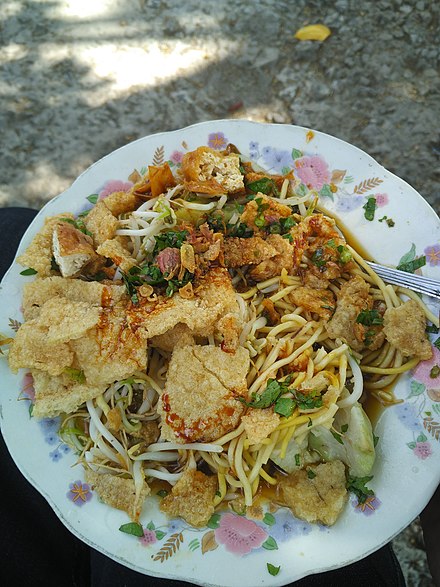 Although Javanese cuisine already exists in almost all parts of Indonesia, there are Javanese dishes that are only available on the island of Java such as Central Java and East Java which are typical foods of each cities.
Although Javanese cuisine already exists in almost all parts of Indonesia, there are Javanese dishes that are only available on the island of Java such as Central Java and East Java which are typical foods of each cities.
Rice
- Lontong balap. , made of lontong (pressed rice cake), tauge (bean sprouts), fried tofu, lentho (fried mashed beans), fried shallots, sambal petis and sweet soy sauce. It is served with clam satay. You can find this dish in Surabaya.
- Nasi krawu. , a delicacy of Gresik. The rice served with banana leaves and its side dishes are beef cutlets, beef stews, beef offal, sambal petis, and serundeng.
Noodles
- Mie kopyok. , boiled noodles served in garlic soup, slices of fried tofu, lontong, bean sprouts, and crushed of kerupuk gendar, sprinkled with sliced fresh celery, and fried shallot. It is served with kecap manis on top. It is specialty from Semarang.
- Mie pentil. , a noodle made from tapioca with chewy texture from Bantul, Yogyakarta. Other local Bantul noodles are mie letheg. and miedes. .
- Mie toprak, One of Surakarta Sunanate dishes, noodle soup with beef, tofu, tempeh, bean sprout, and peanut. It is sprinkled with fried shallot.
Seafood
- Kare rajungan, a blue crab curry soup. The specialty of Tuban, East Java.
Maluku
 Maluku cuisine usually is dominated by seafood because of the abundance of seafood there.
Maluku cuisine usually is dominated by seafood because of the abundance of seafood there.
- Gohu ikan. , a local sashimi of Ternate. a cubed tuna or skipjack, salt, lime, basil, hot cooking oil mixed in a raw state.
- Ikan kuah kuning, a saltwater fish in a yellow soup.
- Nasi kelapa, a rice dish with grated coconut mixed with chillies, shallots, and orange juice.
- Nasi lapola. , rice combines processed tolo nuts (black-eyed peas), grated coconut, lemongrass, lime leaves, pandan leaves, and other complementary spices.
- Papeda. , a congee made from sago starch, eaten with ikan kuah kuning.
- Sambal colo-colo. , fresh raw sambal of bird's eye chili, shallots, red tomatoes, and a pinch of salt and sugar, mixed with fresh calamansi juice or locally known as lemon cui and basil.
- Tumis bia, a spicy stir-fried sea snail.
Minahasan
Main article: Manado#Eat
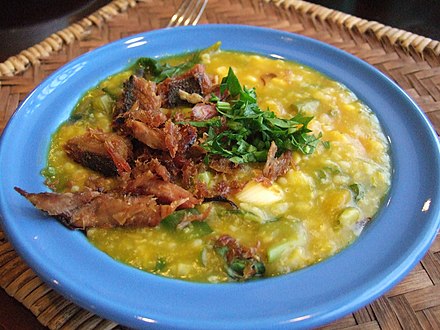
- Ayam rica-rica. , chicken with murderously spicy red chilli sauce.
- Sambal dabu-dabu. , a type of spicy condiment commonly found in Manado cuisine of North Sulawesi, Indonesia. Dabu-dabu consists of diced red chili peppers, bird's eye chili, shallots, red and green tomatoes, salt, sugar, and mixed with fresh calamansi juice.
- Tinutuan. , a goopy but tasty porridge of rice, pumpkin and vegetables. The tinutuan is added a yellow noodle called miedal.
- Woku. , an Indonesian type of bumbu (spice mixture) found in Manado cuisine. Almost any kind of meat, poultry, and seafood can be made as a woku dish. The most common and popular are ayam woku (chicken woku) and kakap woku (red snapper woku).
Minang
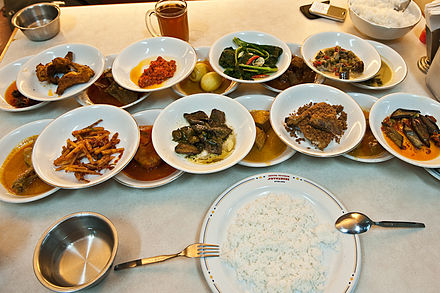 Minang or Minangkabau cuisine also known as Padang cuisine is originating from West Sumatra. The ubiquitous nasi padang and rendang had their origins in Minangkabau cuisine, but are now popular all over Indonesia and in neighboring Malaysia and Singapore.
Minang or Minangkabau cuisine also known as Padang cuisine is originating from West Sumatra. The ubiquitous nasi padang and rendang had their origins in Minangkabau cuisine, but are now popular all over Indonesia and in neighboring Malaysia and Singapore.
- Ayam pop. , Padang style chicken. The dish contains skinless pale fried chicken that has been boiled or steamed prior to frying.
- Balado. , a type of hot and spicy bumbu (spice mixture) found in Minang cuisine. Balado sauce is made by stir-frying ground red hot chili pepper with other spices including garlic, shallot, tomato, and kaffir lime (leaves, fruit, or both) in coconut or palm oil.
- Dendeng batokok. , thin crispy beef.
- Gulai. , a type of food containing rich, spicy and succulent curry-like sauce.
- Itiak lado mudo. , processed duck meat and special spices and then mixed with curly green chili that has been ground.
- Nasi kapau. , a Minangkabau steamed rice topped with various choices of dishes originated from Nagari Kapau, Bukittinggi.
- Lemang. , a Minangkabau traditional food made from glutinous rice, coconut milk, and salt, cooked in a hollowed bamboo tube coated with banana leaves in order to prevent the rice from sticking to the bamboo.
- Tambusu. , the beef intestines are filled with eggs and tofu.
Nusa Tenggara
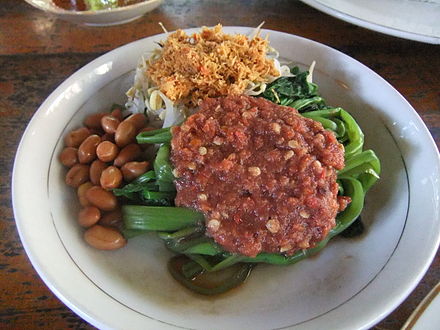
- Ayam Taliwang. , a spicy Indonesian ayam bakar (grilled chicken) dish. Often considered Lombok's top dish, but actually hails from the town of Taliwang in neighboring Sumbawa.
- Plecing kangkung. , an Indonesian spicy water spinach dish from the island of Lombok. Plecing kangkung is made from blanched water spinach leaves and served cold with plecing sambal made from ground red chili pepper, shallot, garlic, bird's eye chili, candlenut, kaffir lime, shrimp paste, salt, and sugar.
- Se'i. , a slice of Indonesian smoked meat from Kupang, West Timor, East Nusa Tenggara. It may be derived from a variety of meats, with pork (se'i babi), beef (se'i sapi) or game animals such as venison (se'i rusa) as common offerings. It is served with specialty condiment called sambal lu'at.
- Singang, a typical Sumbawa fish soup.
Palembangese
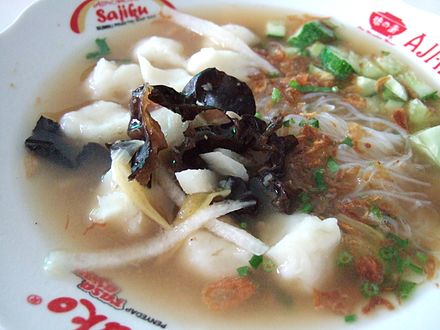
- Kue srikaya, sweet green pandan cake.
- Lenggang. , the dough of sago flour and fish is wrapped in banana leaves and then burned.
- Mie celor. , noodle soup dish served in a coconut milk and shrimp-based broth, specialty of Palembang city.
- Tekwan. , a Palembangese fish cake soup.
Papuan
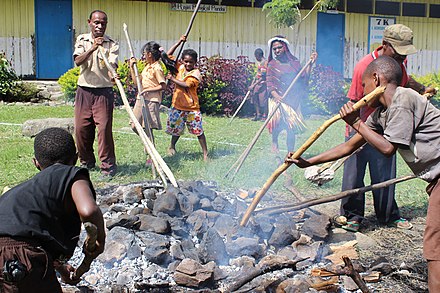 Papua food revolves around a Melanesian diet of boar, sweet potato and taro cooked in some hot stones called Barapen or Bakar batu. It can be found in the highlands of Papua. In lowland and coastal areas, freshwater and marine products are the main food. As a stronghold of Christianity, Papuan cuisine makes frequent use of non-halal ingredients, so be sure to ask the vendor if you are unsure.
Papua food revolves around a Melanesian diet of boar, sweet potato and taro cooked in some hot stones called Barapen or Bakar batu. It can be found in the highlands of Papua. In lowland and coastal areas, freshwater and marine products are the main food. As a stronghold of Christianity, Papuan cuisine makes frequent use of non-halal ingredients, so be sure to ask the vendor if you are unsure.
- Abon gulung. , rolls with abon (floss) in the middle. A delicacy of Manokwari city.
- Keladi tumbuk. boiled taro then pounded until smooth. It is served with ferns, papaya flowers, smoked fish, and sambal.
- Keripik keladi, a sweet and spicy taro chips from Sorong.
- Kue lontar, a condensed milk pie.
- Sate rusa, a deer satay, specialty of Merauke city.
- Udang selingkuh, a crayfish dish in Baliem Valley.
- Ulat sagu, raw sago caterpillar.
Riau Malay

- Bolu kemojo. , a green coloured cake. The green color comes from suji (Dracaena angustifolia) leaf water mixed with pandan leaf water.
- Gulai ikan patin, a catfish curry soup. You may find this dish in the capital of Riau, Pekanbaru.
Noodles
- Mie lendir, has a thick brown sauce, this sauce is mixed with several ingredients such as peanuts and sweet potatoes which are the basic ingredients in the sauce.
- Mie sagu, a noodle dish made from sago starch. It is a common dish in Selatpanjang.
- Mie tarempa. , The food was discovered in the Anambas Island Regency. Mie tarempa is unique for its reddish looks, optional choice of meat, and wide and chewy noodles. The taste of the dish can be described as a mixture of sweet, sour, and spicy.
Sundanese
nasi timbel (rice in banana leaf) with ayam penyet ("smashed" fried chicken), sambal chili sauce and lalapan fresh veggies](https://upload.wikimedia.org/wikipedia/commons/thumb/1/12/NasiTimbelAyamPenyet.JPG/440px-NasiTimbelAyamPenyet.JPG)
Main article: West Java#Eat
Sundanese cuisine originates from West Java, but can be found nationwide. It's characterized by heavy use of raw vegetables, which are rarely seen elsewhere in the archipelago. Key dishes include:
- Cilok. , a Sundanese snack, ball-shaped dumpling made from aci (tapioca starch).
- Karedok. , similar to gado-gado, but the vegetables are finely chopped and mostly raw.
- Lalap. , raw vegetables dipped in sambal.
- Mie kocok. , a beef noodle soup. The dish consists of noodles served in rich beef consommé soup, kikil (beef tendon or slices of cow's trotters), bean sprouts, and bakso (beef meatball), kaffir lime juice, and sprinkled with sliced fresh celery, scallion, and fried shallot.
- Nasi timbel. , white steamed rice wrapped in a banana leaf, a common accompaniment to Sundanese food.
- Nasi tutug oncom. , rice mixed with oncom fermented beans.
- Sate maranggi. , a beef satay served with raw sambal of tomato, chilli, shallot, and lime.
Drink
Quite a few Indonesians believe that cold drinks are unhealthy, so specify dingin when ordering if you prefer your water, bottled tea or beer cold, rather than at room temperature.
Juices
Fruit juices — prefixed by jus for plain juice, panas for heated (usually only citrus drinks), or es if served with ice (not to be confused with the dessert es buah); are popular with Indonesians and visitors alike. Just about every Indonesian tropical fruit can be juiced. Jus alpukat, found only in Indonesia, is a tasty drink made from avocados, usually with some condensed chocolate milk or, at more expensive places, chocolate syrup poured around the inside of the glass prior to filling it. For a total refreshment, you can try air kelapa (coconut water), easily found at virtually every beach in the country. Some juices have become special region beverages like Medan's jus martabe made from tamarillo and passion fruit also Ambon's jus gandaria made from plum-mango. Still, in Depok, there are juices for food souvenirs that are jus belimbing (starfruit juice), jus lidah buaya (aloe vera juice), and jus rumput laut (seaweed juice).
It is very common to mix some fruits and vegetables into a single drink.
Coffee
 Indonesians drink both kopi (coffee) at least as long as they have had vast quantities of sugar added in. An authentic cup of coffee, known as kopi tubruk, is strong and sweet, but let the grounds settle to the bottom of the cup before you drink it. Some coffee beans are named after areas and have different tastes, those are:
Indonesians drink both kopi (coffee) at least as long as they have had vast quantities of sugar added in. An authentic cup of coffee, known as kopi tubruk, is strong and sweet, but let the grounds settle to the bottom of the cup before you drink it. Some coffee beans are named after areas and have different tastes, those are:
Bali
- Kopi Kintamani
Java
- Kopi Garut Cibeureum
- Kopi Ijen Raung
- Kopi Muria
- Kopi Temanggung
- Kopi Wonosobo Bowongso
Kalimantan
- Kopi Aranio
Maluku
- Kopi Buli
Nusa Tenggara
- Kopi Flores Bajawa
Papua
- Kopi Moanemani
- Kopi Wamena
Sulawesi
- Kopi Toraja
Sumatra
- Kopi Aceh Gayo
- Kopi Bengkulu
- Kopi Lampung.
- Kopi Mandailing
- Kopi Sidikalang.
No travel guide would be complete without mentioning the infamous kopi luwak. , coffee is made from coffee fruit that has been eaten, the beans partially digested and then excreted by the luwak (palm civet), but even in Indonesia, this is an exotic delicacy costing upwards of Rp200,000 for a small pot of brew. However, conservationists advise against this drink due to the cruel conditions in which many of the civet cats are kept. But now many stalls in the shopping malls serve up to 20 combinations of coffee beans and produce with grinding and coffee maker for less than Rp20,000, but be ready to stand when you drink it. Besides kopi luwak, there is also a unique coffee bean from Sigi, Central Sulawesi, called kopi toratima. , the coffee beans are taken from the chewing remnants of nocturnal animals that eat coffee cherries at night, such as tarsiers, bats, or Sulawesi dwarf cuscus.
 There are numerous regional coffee drinks around Indonesia such as:
There are numerous regional coffee drinks around Indonesia such as:
- Es kopi susu gula aren, an iced milk coffee with palm sugar.
- Kopi dabe, a coffee boiled with cloves, nutmeg, pandan, and cinnamon in a clay pot. A Tidore drink.
- Kopi ijo. , a coffee mixed with mung bean powder from Tulungagung, East Java.
- Kopi jahe, a coffee with ginger.
- Kopi jos. , Yogyakarta coffee drink with hot charcoal.
- Kopi khop, the coffee is served in a glass that is placed upside down on a small plate and drunk by sipping or sucking the coffee liquid in the small plate until leaving the coffee grounds in the upside-down glass. An Aceh specialty.
- Kopi kothok. , coffee and sugar boiled in a hot water. It is very common in Cepu and Padangan, Bojonegoro.
- Kopi pala, a coffee drink with nutmeg become specialty from Banda Islands.
- Kopi rarobang. , a coffee drink from Ambon. A coffee mixed with white ginger, honey, and walnuts.
- Kopi sanger. Aceh coffee with milk and sugar.
- Kopi santan. , a coffee mixed with coconut milk has become a specialty drink from Blora, Central Java.
- Kopi takar, In North Sumatra, precisely at Mandhailing Natal, you can enjoy a coffee with palm sugar served with coconut shells. This black coffee is also given cinnamon which is usually used for sipping coffee.
Tea
Tea (teh) is also quite popular among Indonesian because there are a lot of tea plantations around the country like in Java, Sumatra, and a small part of Kalimantan and Sulawesi. Every food stall always serves tea in hot or iced. Besides common ice or hot tea, there are some tea drinks in Indonesia:
- Teh hijau, a green tea.
- Teh hitam, a black tea.
- Teh merah, a red tea. It is produced in West Java.
- Teh poci. , a tea specially brewed in clay pots and cups. This drink is added with rock sugar and drunk hot. You can easily find it in Tegal.
- Teh putih, a white tea.
- Teh serai, a tea drink with lemongrass.
- Teh susu, a milk tea. There are two versions, use fresh milk or condensed milk.
- Teh talua. , a drink from West Sumatra made from tea powder, raw egg, sugar, and citrus.
The Coke-like glass bottles Teh botol of the Sosro brand of sweet bottled tea and cartons and bottles of Fruit Tea are ubiquitous with various flavours of fruits, as is Tebs, a carbonated tea. In shopping areas, you can often find vendors selling freshly poured large cups of tea, often jasmines, such as 2Tang or the stronger Tong Tji jasmine, fruit, and lemon teas for as little as Rp2,000.
Jamu
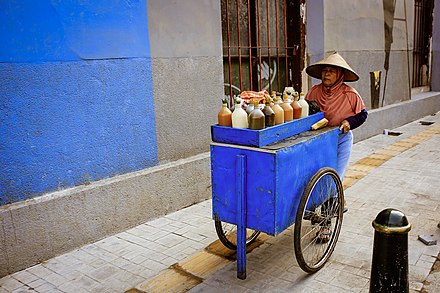 The label jamu. covers a vast range of local medicinal drinks for various diseases. Jamu are available in ready-to-drink form, in powder sachets or capsules, or sold by women walking around with a basket of bottles wrapped to them by a colourful length of Batik kain (cloth). Most of them are bitter or sour and drunk for the supposed effect, not the taste. Famous brands of jamu include Iboe, Sido Muncul, Jago, and Nyonya Meneer; avoid buying jamu from the street as the water quality is dubious. Some well-known jamu include:
The label jamu. covers a vast range of local medicinal drinks for various diseases. Jamu are available in ready-to-drink form, in powder sachets or capsules, or sold by women walking around with a basket of bottles wrapped to them by a colourful length of Batik kain (cloth). Most of them are bitter or sour and drunk for the supposed effect, not the taste. Famous brands of jamu include Iboe, Sido Muncul, Jago, and Nyonya Meneer; avoid buying jamu from the street as the water quality is dubious. Some well-known jamu include:
- Beras kencur. (from rice, sand ginger and brown sugar) — cough, fatigue.
- Galian singset — weight reduction.
- Gula asem (from tamarind and brown sugar) — rich in vitamin C.
- Kunyit asam (from tamarind, turmeric) — for skin care, canker sores.
- Temulawak (from curcuma) — for liver disease.
Chase a sour or bitter jamu with beras kencur, which has a taste slightly reminiscent of anise. If you'd like a semeriwing (cooling) effect, request kapu laga (cardamom) or, for heating, add ginger.
Traditional drinks

 Es means cold drink with ice and Wedang means "drinks brewed with hot water" in Indonesian. Each province and even city has its own specialty of drinks and is not limited to lists. You may ask the local guide or local people by saying apa saja minuman khas di daerah sini? (what are the traditional drinks here?) to know more about the local traditional drinks.
Es means cold drink with ice and Wedang means "drinks brewed with hot water" in Indonesian. Each province and even city has its own specialty of drinks and is not limited to lists. You may ask the local guide or local people by saying apa saja minuman khas di daerah sini? (what are the traditional drinks here?) to know more about the local traditional drinks.
- Air guraka, Ternate hot drink made from ginger, brown sugar, and walnut.
- Bajigur. , made from coffee, salt, brown sugar, coconut milk, sugar palm fruit, and vanillin.
- Bandrek. , made from brown sugar, ginger, pandanus (aka screwpine) leaf, coconut meat, clove bud, salt, cinnamon, and coffee.
- Cinna-Ale, made from cinnamon, ginger, tamarind, sand ginger, and 13 other spices.
- Cendol. or Dawet, made from rice flour, sago palm flour, pandanus leaf, salt, food colouring additives in a coconut milk and Javanese sugar liquid. In Purworejo, Central Java, the dawet mixed with rice charcoal powder called dawet ireng.
- Es kelapa muda. , an iced drink of coconut water, coconut flesh, and sweetener liquid like syrup, honey, or liquified jaggery. It can be added lime juice and tape (fermented cassava or fermented glutinous rice).
- Es kuwut, a drink from Bali, made from coconut, citrus, honeydew, and selasih (basil seeds).
- Es lidah buaya, a drink from West Kalimantan, made from aloe vera, French basil, Javanese black jelly, coconut milk, palm sugar, pandanus leaf, and sugar.
- Es selendang mayang. , a Betawi cold drink made from mixed rice and palm flour jelly with sweet coconut milk and ice.
- Ronde, made from ginger, powdered glutinous rice, peanut, salt, and sugar.
- Saraba, the hot drink is made from ginger water mixed with brown sugar, eggs, and milk or coconut milk stew. Specialty from Makassar.
- STMJ, a hot drink made from milk, raw egg, honey, and ginger.
- Wedang kacang tanah, peanut hot drink from Semarang.
- Wedang sekoteng. , made from ginger, green pea, peanut, pacar cina (tapioca pearls), milk, sugar, and salt.
- Wedang serbat, made from star anise, cardamon, tamarind, ginger, and sugar.
- Wedang uwuh, made from herbs and sappanwood. A "red" wedang is common in Central Java.
Alcohol
 Islam is the religion of the majority of Indonesians, but alcohol is widely available in most areas, especially in upscale restaurants and bars. Public displays of drunkenness are strongly frowned upon and in the larger cities are likely to make you a victim of crime or get you arrested by police. Do not drive if you are drunk. The legal drinking age is 21 and supermarkets have begun enforcing ID checks for alcohol purchases.
Islam is the religion of the majority of Indonesians, but alcohol is widely available in most areas, especially in upscale restaurants and bars. Public displays of drunkenness are strongly frowned upon and in the larger cities are likely to make you a victim of crime or get you arrested by police. Do not drive if you are drunk. The legal drinking age is 21 and supermarkets have begun enforcing ID checks for alcohol purchases.
In staunchly Islamic areas such as Aceh alcohol is banned and those caught with alcohol can be caned.
Indonesia's most popular tipple is Bintang bir (beer), a standard-issue lager available more or less everywhere, although the locals like theirs lukewarm. Other popular beers include Bali Hai and Anker (dead link: December 2020). In mid-April 2015, supermarkets and mini markets across Indonesia are "clean", meaning they no longer sell alcoholic drinks. However, cafes, bars and restaurants with appropriate licenses can continue to sell alcoholic drinks, including hard liquor. Tourist areas are exempted at the discretion of each regent and mayor, who can decide which area with small vendors or 'warung' can serve/sell 1-5% alcohol drinks. They can cost as much as Rp50,000 in a fancy bar, but a more usual bar/restaurant price for Bintang is Rp25,000-35,000 for a big 0.65 litre bottle.
Wine is expensive and only available in expensive restaurants and bars in large hotels. Although you can still find some wines in the big supermarkets within some big malls in big cities. Almost all of it is imported, but there are a few local vintners of varying quality on Bali whose wine is cheaper. 30 percent of alcohol drinks are imported and new taxation scheme of imported alcohol drinks are 150 percent of base price and 90 percent of base price for imported beers.
Various traditional alcoholic drinks are also available:
- Arak — the distilled version of tuak, up to 40%.
- Brem — Bali-style sweet glutinous rice wine.
- Tuak — sugar palm wine (15% alcohol).
Exercise some caution in choosing what and where to buy — homemade moonshine may contain all sorts of nasty impurities. In May 2009, 23 people, including four tourists, were killed by adulterated, or possibly inadvertently contaminated illicitly-supplied arak distributed in Java, Bali and Lombok. In many other cases, tourists have been blinded or killed by methanol in drinks. If you want to save money in Indonesia, don't do it by buying the cheapest alcohol you can find. Buying it at supermarkets would usually be the safest option.
Restaurants
Many food stalls are easy to find, from big cities to sub-districts or villages with the majority of the menu being rice with vegetables and protein side dishes. Also, mineral water, tea, lemonade, or instant coffee have become a standard drink in the food stall.
Type of restaurants
There are travelling vendors who carry a basket of pre-prepared food (usually women), or who carry two small wooden cabinets on a bamboo stick (usually men), who may serve light snacks or even simple meals, some of which are very cheap and enjoyable. Other travelling vendors use pedaled rickshaws and pushed food carts.
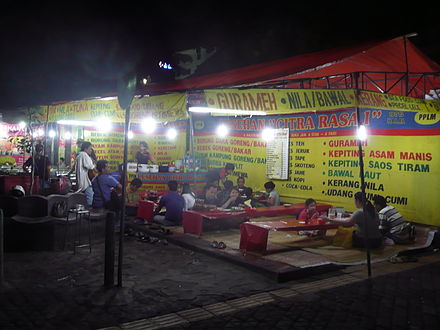 The fastest way to grab a bite is to visit a kaki lima, literally "five feet". Depending on whom you ask, they're named either after the mobile stalls' three wheels plus the owner's two feet, or the "five-foot way" pavements. These can be found by the side of the road in any Indonesian city, town or village, usually offering up simple fares like fried rice, noodles, meatball soup, siomay (dimsum) and porridge. At night, a kaki lima can turn into a lesehan (sitting on the floor with mat and table) eatery simply by providing some bamboo mats or carpet for customers to sit on and chat, but they may provide plastic stools or even benches, and tables.
The fastest way to grab a bite is to visit a kaki lima, literally "five feet". Depending on whom you ask, they're named either after the mobile stalls' three wheels plus the owner's two feet, or the "five-foot way" pavements. These can be found by the side of the road in any Indonesian city, town or village, usually offering up simple fares like fried rice, noodles, meatball soup, siomay (dimsum) and porridge. At night, a kaki lima can turn into a lesehan (sitting on the floor with mat and table) eatery simply by providing some bamboo mats or carpet for customers to sit on and chat, but they may provide plastic stools or even benches, and tables.
A step up from the kaki lima is the warung (or the old spelling waroeng), a slightly less mobile stall offering much the same food, but perhaps a few plastic stools and a tarp for shelter. Some warung are permanent structures.

A rather more comfortable option is the rumah makan (lit: eating house), a basic restaurant more often than not specializes in a certain cuisine. Padang restaurants, easily identified by their soaring Minangkabau roofs, typically offer rice and an array of curries and dishes to go along with it. Ordering is particularly easy: just sit down, and your table will promptly fill up with countless small plates of dishes. Eat what you want and pay for what you eat.
Buffets (prasmanan or buffet) and steamboat restaurants are self-service choices, but the former should be approached warily.
Another easy mid-range option in larger cities is to look out for food courts (known there as Pujasera, short for Pusat Jajanan Serba Ada, which translates to All-in-one snack center in English) and Indonesian restaurants in shopping malls, which combine air conditioning with hygienic if rather predictable/boring food.
A restoran indicates more of a Western-style eating experience, with air conditioners, table cloths, table service, and prices to match. Especially in Jakarta and Bali, it's possible to find very good restaurants offering authentic fare from around the world, but you'll be lucky to escape for under Rp100,000 a head.
Chains
Most chain restaurants in Indonesia have ample seating areas. Most offer meals set, so it is one of the cheapest (and most often, also the cleanest) option. Famous chains to look for:
- Hoka Hoka Bento (also known as Hokben) offers Japanese-style fast food. (And no, there is no Hoka Hoka Bento in Japan!). You can get rice with teriyaki and fried chicken, egg roll, or shrimp for about Rp50,000 or less, plus a drink, salad, and miso soup.
- Bakmi GM is famous for its ubiquitous types of noodle entrées (including its very own special version of noodle dish) and its fried wontons (pangsit goreng), although it also offers dishes of rice. A good meal usually costs Rp50,000 or less.
- Es Teler 77 is one of the oldest fast food chains in Indonesia, in business since 1982, and has more than 200 outlets throughout Indonesia. Offers Indonesian dishes such as bakso, and as its name suggests, es teler. Dishes cost about Rp50,000 (incl. Food + Drinks).
- Indonesia's Pizza Hut restaurants look like more of a fine dining option rather than a fast food franchise like its original location, the United States. The pizzas have more generous types of toppings and crust, and also more options for sides & pasta. It is also famous for its waitresses or waiters who would make miniatures from balloons to children. In addition, also operates a separate business unit called PHD (Pizza Hut Delivery) with its own menu exclusive for delivery in selected cities.
- Kebab Turki Baba Rafi is the world's largest kebab restaurant chain. The kebabs, shawarma, hot dogs, and fries are very affordable for a quick meal. It can usually be found as food court stalls.
- Most imported minimart stores such as FamilyMart, Circle K and Lawson provide prepared meals that the staff can heat for you, in addition to the usual groceries you typically find, for less than Rp30,000. Local chains such as Indomaret and Alfamart have a lot more branches but are more like a typical minimart. At best it provides bread or salad as a prepared meal, though nowadays both Indomaret and Alfamart are stepping up their quality to provide similar services as the imported convenience stores.
- Transmart or Lotte Mart supermarkets have areas for products such as bakery & snacks, but most people will do a takeaway instead of a dine-in although some seating is available.
American fast food franchises McDonalds, KFC, Wendy's, Burger King, or A&W also maintain their presence in just about every mall in Indonesia. Other chains from around the globe, such as the world-famous Yoshinoya, can be found in more upscale malls.
Ordering
Outside the touristy bits of Bali, a typical Indonesian menu is a sparse affair listing the name of the dish, the price and nothing else. Street stalls tend to specialize quite narrowly and the menu is often just a single dish, whose name is painted onto the stall itself. Learning some basic food terms like such as goreng (deep-fried or stir-fried), bakar (grilled), rebus (boiled), kuah (in gravy), mi or mie (noodle) will take you a long way.
At almost all Indonesian restaurants you can just sit down and a waiter will come take your order. You can order dishes simply by pointing at them on the menu, saying ini (this one). The waiter will ask, berapa (how much?) You may say satu (one), or dua (two) etc. You can also use your finger for the amount of food you order. Then, the waiter will repeat your order for your confirmation.
If you want to leave, call the waiter by raising your right hand and saying mau bayar or minta bil nya and the waiter will give you the bill. Or, you may go to the cashier before you leave.
Dietary restrictions
Indonesia off the beaten track can be a tough place if you have dietary restrictions.
Eating vegetarian
Strict vegetarians and vegans will have a tough time in Indonesia, as the concept is poorly understood, and avoiding fish and shrimp-based condiments is a challenge. Tahu (tofu aka soybean curd) and its chunkier, indigenous cousin tempe (soybean cake) are an essential part of the diet, but they are often served with non-vegetarian condiments. For example, the ubiquitous sambal chili pastes very often contain shrimp, and kerupuk crackers with a spongy appearance, including those always served with nasi goreng, nearly always contain shrimp or fish. (Those that resemble potato chips, on the other hand, are usually fine.) You can, however, ask them to make something without meat, which can be indicated by asking for "vegetarian" or tanpa daging, tanpa hasil laut (without meat, without seafood)". Gado-gado ("salad" with peanut sauce) is typically vegetarian, nasi goreng can be if prepared without meat. Restaurants are usually willing to take special orders.
Eating halal
With nearly 90% of Indonesians practicing Islam, eating halal is generally not an issue, although you may need a little more effort if you travel within a Muslim minority area such as Bali, North Sumatra, East Nusa Tenggara, Papua, and North Sulawesi. Genuine halal restaurants have a certificate issued by the Majelis Ulama Indonesia (MUI) hung on their wall, and this also includes most fast food chains, however even those that do not have the certificate are by default halal except Chinese restaurants and those otherwise explicitly indicated with the word pork (babi) or non-halal. Most restaurants at hotels generally are not halal as they serve alcohol, but with the exception of Chinese restaurants, they do not generally serve pork.
Allergies
Allergies are poorly understood in Indonesia. A severe soy allergy is basically incompatible with Indonesian food, since soy sauce, tofu, tempeh etc are ubiquitous. The rice-based diet makes staying gluten free easier, but cross-contamination is hard to avoid.
Respect
Etiquette
Eating with your hand (instead of utensils like forks and spoons) is very common. The basic idea is to use four of your fingers to pack together a little ball of rice and other things, which can then be dipped into sauces before you pop it in your mouth by pushing it with your thumb. There's one basic rule of etiquette to observe: Use only your right hand, as the left hand is deemed as impolite. Don't stick either hand into communal serving dishes: instead, use the left hand to serve yourself with utensils and then dig in.
However, eating by hand is frowned upon in "classier" places. If you are provided with cutlery and nobody else around you seems to be doing it, then take the hint. Equally common are chopsticks, forks, spoons, and knives, although knives are somewhat rare, except for upscale restaurants. It is considered polite and a sign of enjoyment to eat quickly, and some people view burping as a compliment.
